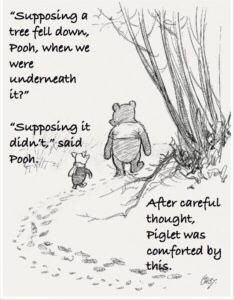
For years we as a company have avoided tree risk assessments, I’ve always taken the same view as Winnie the pooh, although a large vocal part of the industry seems to be obsessed with them to the point where the risk has become overstated or that we’re looking at something which is pretty rare.
Let us be honest the risk of death caused by trees is less than 1/14000000.
That’s pretty damn low, if fact you’ve got a higher chance of winning the lottery, being struck by lightning or eaten by bears than being killed by a tree or part of a tree so why are we worrying about tree risk?
We worry about Tree risk because it’s part of the Occupier’s Liability Act and its linked duty of care.
So we have to do something about it and at the very least have a recorded trail for audit. Now there are various methods we can use, some rely on a self-constructed method loosely based on VTA, and some use a scheme constructed by others. There are a few, but to our eyes, and several others including the courts, QTRA is the most sensible and recognised methodology there is and possibly the only one that can put a relatable number and a recognisable colour to the risk level.
QTRA stands for Quantified Tree Risk Assessment and has been on my radar since I read about it shortly after Mike Ellison developed this peer-reviewed methodology, which is regularly updated to reflect changes in legislation and most importantly the numbers, in the early 2000’s. It’s used across the world and taught across the world, courses are regularly held in Australia, Sweden, and the UK.
As such I’ve been on a trip to Merrist Wood for two days on the QTRA course.
The less said about the four-hour trip there the better but after two days split between a classroom and trips outside to look at trees followed by a 100% scored test on Monday, I’m a registered QTRA user, number 7526. All our details are recorded on their website along with other registered users who have all taken the course, kept up with legislation any updates, and if they really are registered users like they claim, traceable by their number.
It also means that moving forward we will now be doing more Tree Risk Assessments, using a pragmatic sensible approach that can present the incredibly low level of risk of harm from trees, without a lot of unnecessary numberwang, waffle, and recommendations.